Marrying Vega and Zen: The AMD Ryzen 5 2400G Review
by Ian Cutress on February 12, 2018 9:00 AM ESTBenchmarking Performance: CPU Office Tests
The office programs we use for benchmarking aren't specific programs per-se, but industry standard tests that hold weight with professionals. The goal of these tests is to use an array of software and techniques that a typical office user might encounter, such as video conferencing, document editing, architectural modelling, and so on and so forth.
All of our benchmark results can also be found in our benchmark engine, Bench.
Chromium Compile (v56)
Our new compilation test uses Windows 10 Pro, VS Community 2015.3 with the Win10 SDK to combile a nightly build of Chromium. We've fixed the test for a build in late March 2017, and we run a fresh full compile in our test. Compilation is the typical example given of a variable threaded workload - some of the compile and linking is linear, whereas other parts are multithreaded.
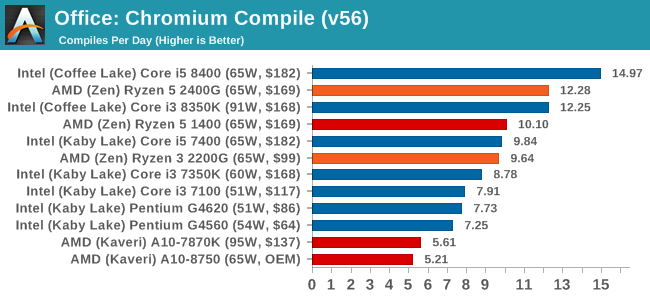
Our compile test has an eclectic mix of requirements, with different segments having different bottlenecks. The Ryzen 5 2400G matches the higher frequency of the Core i3-8350K, even though it already has a core and memory advantage. An interesting thing here is that the Ryzen 3 2200G and the Ryzen 5 1400 are almost evenly matched, even though the 1400 has double the threads. This is because of the frequency of the 2200G, and the memory speed.
PCMark 10
PCMark 10 is the latest all-in-one office-related performance tool that combines a number of tests for low-to-mid office workloads, including some gaming, but focusing on aspects like document manipulation, response, and video conferencing.

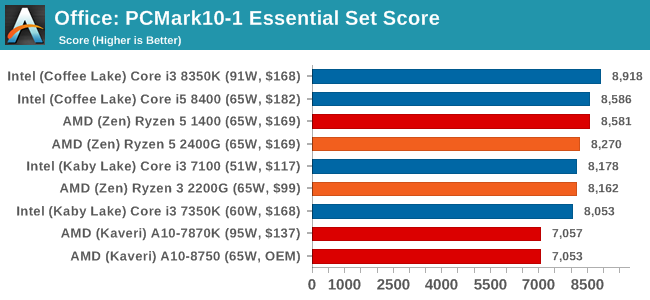
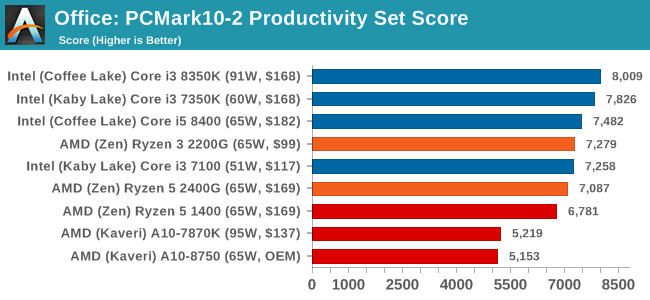
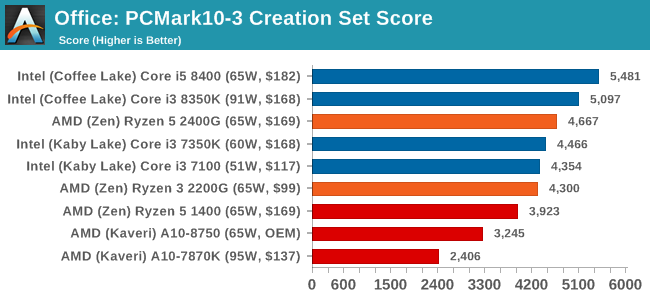
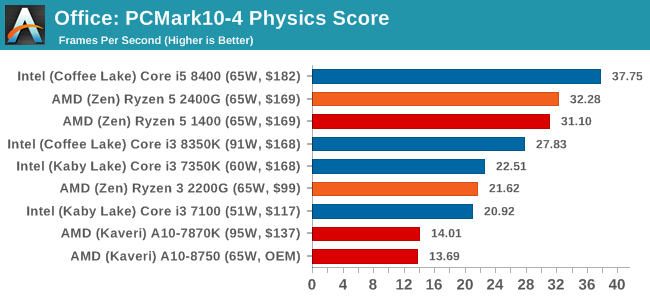
PCMark8: link
Despite originally coming out in 2008/2009, Futuremark has maintained PCMark8 to remain relevant in 2017. On the scale of complicated tasks, PCMark focuses more on the low-to-mid range of professional workloads, making it a good indicator for what people consider 'office' work. We run the benchmark from the commandline in 'conventional' mode, meaning C++ over OpenCL, to remove the graphics card from the equation and focus purely on the CPU. PCMark8 offers Home, Work and Creative workloads, with some software tests shared and others unique to each benchmark set.
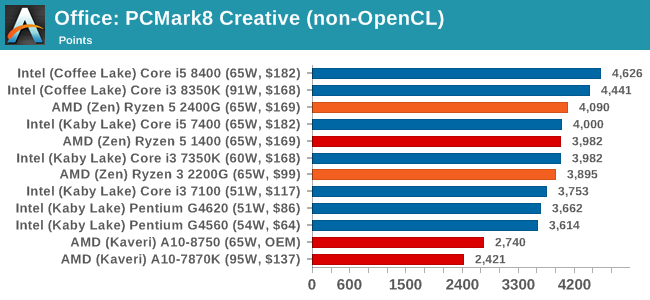
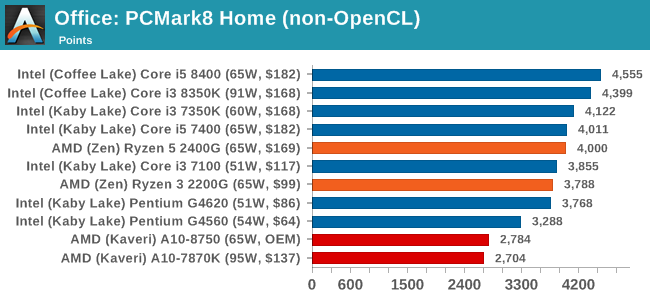
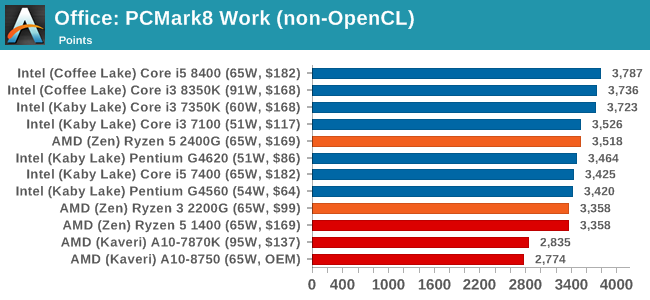










177 Comments
View All Comments
haplo602 - Tuesday, February 13, 2018 - link
Finally one review where I can see the driver version ... So this is the same driver used also for the Ryzen mobile APUs. Can you check if you can force/manual install the latest Adrenaline drivers ? That works on some of the Ryzen 2500u chips and actually increases the performance by some 15+% ...haplo602 - Tuesday, February 13, 2018 - link
I hope there's a memory scaling article in the future with frequency and CL scaling for the APU part ...crotach - Tuesday, February 13, 2018 - link
What about HTPC use?I was considering GT 1030 + Intel route for H265 and HDR10 playback and was really looking forward to Zen APUs, but there doesn't seem to be any motherboards with HDMI 2.0?!
Also, I wonder if the chips can be undervolted and underclocked to bring them to a near silent noise level for the living room.
Lolimaster - Tuesday, February 13, 2018 - link
You can undervolt and underclock ANY intel or amd cpu.forgerone - Tuesday, February 13, 2018 - link
What most writers and critics of integrated graphics processors such as AMD's APU or Intel iGP all seem to forget, is not EVERYONE in the world has a disposable or discretionary income equal to that of the United States, Europe, Japan etc. Not everyone can afford bleeding edge gaming PC's or laptops. Food, housing and clothing must come first for 80% of the population of the world.An APU can grant anyone who can afford at least a decent basic APU the enjoyment of playing most computer games. The visual quality of these games may not be up to the arrogantly high standards of most western gamers, but then again these same folks who are happy to have an APU also can not barely afford a 750p crt monitor much less a 4k flat screen.
This simple idea is huge not only for the laptop and pc market but especially game developers who can only expect to see an expansion of their Total Addressable Market. And that is good for everybody as broader markets help reduce the cost of development.
This in fact was the whole point behind AMD's release of Mantle and Microsoft and The Kronos Group's release of DX12 and Vulkan respectively.
Today's AMD APU has all of the power of a GPU Add In Board of not more than a several years back.
krazyfrog - Tuesday, February 13, 2018 - link
Why did you leave out the 8400 and the 1500X in these comparisons?Kamgusta - Wednesday, February 14, 2018 - link
Because these CPUs, while having the same price range, outperform these Raven Ridge chips. That would have been a bad press for AMD and it seems like Anandtech wants to remains extremely loyal to AMD in these days.msroadkill612 - Tuesday, February 13, 2018 - link
"the data shows both how far integrated graphics has come, and how far it still has to go to qualify for those 'immerse experiences' that Intel, AMD, and NVIDIA all claim are worth reaching for, with higher resolutions and higher fidelity. "This assumes a static situation which is rot.
what it reveals is that in the current paradigm, coders have coded accordingly for satisfactory results. If the paradigm changes and other ways work better, then code evolves.
This unprecedented integration of new gen, sibling cpu & gpu, offers many performance upsides too for future code.
picture a mobo with a discrete gpu like an equivalent 1030, then picture a ~matchbox footprint apu - there is a huge difference in the size of the respective circuits - yet they both do the same job & have to send a lot of data to each other.
it's not hard to figure which is inherently superior in many ways.
I strongly disagree with your blinkered bias.
Pork@III - Tuesday, February 13, 2018 - link
There is something unfinished, something inconsolable.elites2012 - Tuesday, February 13, 2018 - link
anything this chip lost to intel at, was most likely outdated. adobe, fcat, dolphin, pov are all outdated benchmarks.